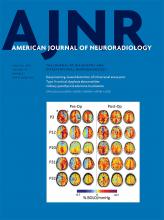We thank Drs Yuan and Sun for their interest in our article1 and their group's recent work on intraplaque hemorrhage (IPH) in carotid plaque.2 While IPH is validated as a high-risk plaque feature in extracranial carotid artery plaque3 due to facile histologic validation from endarterectomy specimens, our current understanding of the role of IPH in intracranial atherosclerotic plaque vulnerability assessment is limited. The characterization of intracranial plaque features by in vivo imaging remains challenging due to the small plaque size and impracticality of histologic validation. The definition of T1-weighted hyperintense signal suggestive of IPH as >150% signal relative to the nearby medial pterygoid muscles on precontrast T1-weighted imaging used in our study was adopted from previous carotid studies and supported by initial studies of IPH within the middle cerebral artery.4
Intracranial IPH is increasingly recognized as a harbinger of elevated stroke risk,5 and our study adds to the literature concerning basilar artery plaque in showing an association with stroke risk independent of the degree of stenosis. We appreciate Drs Yuan and Sun's suggestions on the discussion of imaging sequences for improving the accuracy of intracranial IPH detection. The use of different TR/TE parameters or inversion pulses can alter image contrast, which may partially explain the heterogeneity of prior study results. Histologic validation is preferred to standardize imaging approaches; however, it has practical challenges in intracranial atherosclerotic plaque, which cannot be obtained in vivo. An alternative practical approach to standardize sequences for clinical detection of IPH could be to use phantoms with different T1 values; this method needs to be explored further. In addition, recent studies have increasingly used 3D high-resolution fast spin-echo sequences (sampling perfection with application-optimized contrasts by using different flip angle evolution [SPACE] sequence, Siemens, Erlangen, Germany; CUBE, GE Healthcare, Milwaukee, Wisconsin; or volume isotropic turbo spin-echo acquisition [VISTA], Philips Healthcare, Best, the Netherlands) for intracranial plaque imaging. IPH detection should be used with caution because the long echo-train (>30) induces considerable T2-weighting,6 which alters contrast from traditional 2D T1-weighted fast spin-echo or gradient-echo sequences.
In our study, the degree of stenosis was not associated with stroke symptoms, and the prevalence of IPH was comparable in low- and high-grade stenoses. This finding may reflect IPH as an independent risk factor for stroke symptoms in basilar artery plaque, though the limited sample size in a single-center population could introduce sampling error. Nonetheless, these data highlight the importance of basilar artery IPH even in low-grade stenosis as potentially leading to stroke. High-risk plaque in intracranial arteries with <50% stenosis7 has been recognized as a potential cause of cryptogenic stroke, and identifying these high-risk features, including IPH, may improve the management of these patients. Nonetheless, we agree with Drs Yuan and Sun that both IPH and plaque enhancement should be studied further in a prospective, longitudinal study to better understand potential imaging-related independent risk factors that may predict stroke.
References
- © 2019 by American Journal of Neuroradiology











